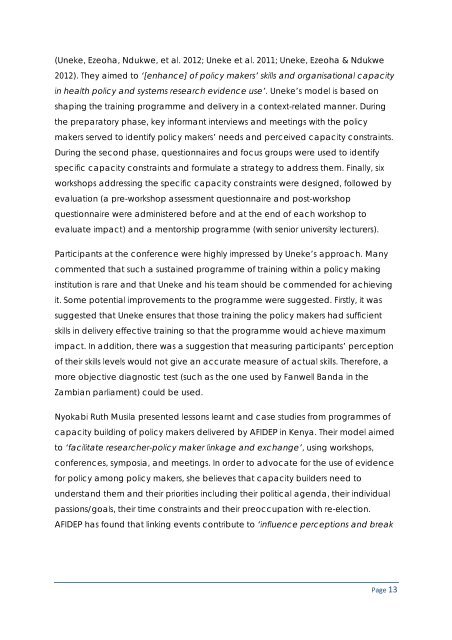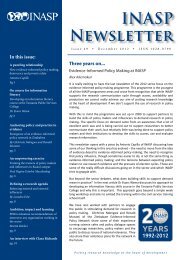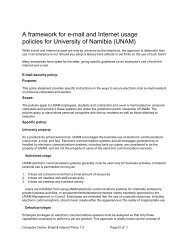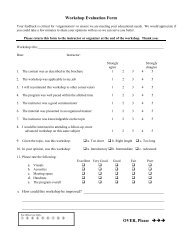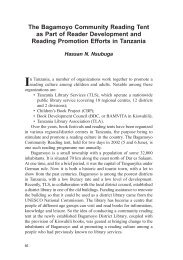What is the evidence on evidence-informed policy making? - INASP
What is the evidence on evidence-informed policy making? - INASP
What is the evidence on evidence-informed policy making? - INASP
You also want an ePaper? Increase the reach of your titles
YUMPU automatically turns print PDFs into web optimized ePapers that Google loves.
(Uneke, Ezeoha, Ndukwe, et al. 2012; Uneke et al. 2011; Uneke, Ezeoha & Ndukwe<br />
2012). They aimed to ‘[enhance] of <strong>policy</strong> makers’ skills and organ<str<strong>on</strong>g>is</str<strong>on</strong>g>ati<strong>on</strong>al capacity<br />
in health <strong>policy</strong> and systems research <str<strong>on</strong>g>evidence</str<strong>on</strong>g> use’. Uneke’s model <str<strong>on</strong>g>is</str<strong>on</strong>g> based <strong>on</strong><br />
shaping <str<strong>on</strong>g>the</str<strong>on</strong>g> training programme and delivery in a c<strong>on</strong>text-related manner. During<br />
<str<strong>on</strong>g>the</str<strong>on</strong>g> preparatory phase, key informant interviews and meetings with <str<strong>on</strong>g>the</str<strong>on</strong>g> <strong>policy</strong><br />
makers served to identify <strong>policy</strong> makers’ needs and perceived capacity c<strong>on</strong>straints.<br />
During <str<strong>on</strong>g>the</str<strong>on</strong>g> sec<strong>on</strong>d phase, questi<strong>on</strong>naires and focus groups were used to identify<br />
specific capacity c<strong>on</strong>straints and formulate a strategy to address <str<strong>on</strong>g>the</str<strong>on</strong>g>m. Finally, six<br />
workshops addressing <str<strong>on</strong>g>the</str<strong>on</strong>g> specific capacity c<strong>on</strong>straints were designed, followed by<br />
evaluati<strong>on</strong> (a pre-workshop assessment questi<strong>on</strong>naire and post-workshop<br />
questi<strong>on</strong>naire were admin<str<strong>on</strong>g>is</str<strong>on</strong>g>tered before and at <str<strong>on</strong>g>the</str<strong>on</strong>g> end of each workshop to<br />
evaluate impact) and a mentorship programme (with senior university lecturers).<br />
Participants at <str<strong>on</strong>g>the</str<strong>on</strong>g> c<strong>on</strong>ference were highly impressed by Uneke’s approach. Many<br />
commented that such a sustained programme of training within a <strong>policy</strong> <strong>making</strong><br />
instituti<strong>on</strong> <str<strong>on</strong>g>is</str<strong>on</strong>g> rare and that Uneke and h<str<strong>on</strong>g>is</str<strong>on</strong>g> team should be commended for achieving<br />
it. Some potential improvements to <str<strong>on</strong>g>the</str<strong>on</strong>g> programme were suggested. Firstly, it was<br />
suggested that Uneke ensures that those training <str<strong>on</strong>g>the</str<strong>on</strong>g> <strong>policy</strong> makers had sufficient<br />
skills in delivery effective training so that <str<strong>on</strong>g>the</str<strong>on</strong>g> programme would achieve maximum<br />
impact. In additi<strong>on</strong>, <str<strong>on</strong>g>the</str<strong>on</strong>g>re was a suggesti<strong>on</strong> that measuring participants’ percepti<strong>on</strong><br />
of <str<strong>on</strong>g>the</str<strong>on</strong>g>ir skills levels would not give an accurate measure of actual skills. Therefore, a<br />
more objective diagnostic test (such as <str<strong>on</strong>g>the</str<strong>on</strong>g> <strong>on</strong>e used by Fanwell Banda in <str<strong>on</strong>g>the</str<strong>on</strong>g><br />
Zambian parliament) could be used.<br />
Nyokabi Ruth Musila presented less<strong>on</strong>s learnt and case studies from programmes of<br />
capacity building of <strong>policy</strong> makers delivered by AFIDEP in Kenya. Their model aimed<br />
to ‘facilitate researcher-<strong>policy</strong> maker linkage and exchange’, using workshops,<br />
c<strong>on</strong>ferences, symposia, and meetings. In order to advocate for <str<strong>on</strong>g>the</str<strong>on</strong>g> use of <str<strong>on</strong>g>evidence</str<strong>on</strong>g><br />
for <strong>policy</strong> am<strong>on</strong>g <strong>policy</strong> makers, she believes that capacity builders need to<br />
understand <str<strong>on</strong>g>the</str<strong>on</strong>g>m and <str<strong>on</strong>g>the</str<strong>on</strong>g>ir priorities including <str<strong>on</strong>g>the</str<strong>on</strong>g>ir political agenda, <str<strong>on</strong>g>the</str<strong>on</strong>g>ir individual<br />
passi<strong>on</strong>s/goals, <str<strong>on</strong>g>the</str<strong>on</strong>g>ir time c<strong>on</strong>straints and <str<strong>on</strong>g>the</str<strong>on</strong>g>ir preoccupati<strong>on</strong> with re-electi<strong>on</strong>.<br />
AFIDEP has found that linking events c<strong>on</strong>tribute to ‘influence percepti<strong>on</strong>s and break<br />
Page 13


